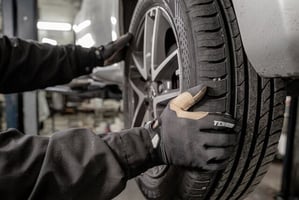Weight distribution is one of the most crucial—and most overlooked—factors in safe towing.
When your trailer’s weight is balanced correctly, you gain smoother handling, safer braking, and a more stable ride. Whether you're pulling a compact camper or a fully loaded cargo trailer, proper weight distribution can make the difference between a confident tow and a white-knuckle drive. It also protects your tow vehicle from excessive strain, reducing the risk of mechanical failures.
And if you want to eliminate sway and gain unmatched weight balance control, the ProPride 3P® Hitch delivers advanced distribution technology trusted by thousands of confident towers.
In this blog, you will learn:
- What weight distribution really means for towing performance
- The most common safety issues caused by improper load balance
- Practical ways to achieve perfect distribution for smoother trips
Let’s break down the basics of how weight distribution works—and how you can master it.
What Is Weight Distribution?
When you tow a trailer, you're not just towing cargo—you’re managing forces. Improper weight distribution puts more downward force on your trailer hitch (tongue weight), lifting the front of your tow vehicle. This imbalance strains your suspension, reduces steering control, and increases sway risk.
What Happens When Weight Is Misplaced?
- Front-heavy setup makes steering sluggish and braking inconsistent.
- Rear-heavy loading often means trailer sway and instability at speed.
- Side-to-side imbalance can lean the vehicle/trailer into curves, risking rollovers.
A weight distribution system—even the basic bars or the advanced ProPride Hitch—helps shift tongue weight across all axles, keeping your towing rig level and responsive.
Why Balanced Weight Matters — The Key Benefits
Proper weight distribution isn't just about balance—it's about overall safety, comfort, and fuel savings. Here’s why it pays to get it right:
- Better Handling: Balanced weight gives you controlled steering and fewer surprises.
- Improved Braking: With weight even across all tires, braking is uniform and predictable.
- Reduced Sway: The trailer stays aligned behind you, even in crosswinds or during heavy traffic.
- Less Wear & Tear: Suspension, tires, and brakes last longer with even load stress.
- Better Fuel Efficiency: A level, stable trailer reduces drag and improves MPG.
Weight Distribution Hitch Options at a Glance
|
System |
Ideal For |
Pros |
Cons |
|
Standard WD Bars |
Light to mid-size trailers |
Affordable and easy to set up |
Requires manual adjustment |
|
Friction Sway Control |
Sway-prone setups |
Adds sway resistance to distribution hitches |
Can wear out components |
|
ProPride 3P® Hitch |
Long-distance and heavy loads |
Eliminates sway, auto-adjusts pivot height |
Higher initial cost but durable |
Use this table to match your trailer needs to the right distribution system for optimal towing performance.
Common Consequences of Poor Weight Distribution
Even small imbalances can escalate into major problems—especially when traction, travel distance, or adverse conditions come into play.
1. Trailer Sway
Uneven weight shifts the trailer’s center of gravity, increasing sway. Once sway begins, regaining control—even with corrective brakes—is often difficult without proactive equipment like the ProPride 3P® Hitch.
2. Reduced Steering Precision
Lifted front ends due to rear-heavy loads reduce steering contact and response. You may notice veering, delayed steering commands, and extreme sensitivity on windy roads.
3. Extended Stopping Distances
You can’t stop what you can’t grip. Off-balance loads mean fewer tires with solid road contact, leading to skids, longer braking distances, and deeper emergency stops.
4. Heightened Mechanical Wear
Front suspensions endure overload and sagging, rear suspensions carry excessive strain, and trailer axles take uneven shock, reducing lifespan and increasing service costs.
Achieving Proper Weight Distribution: Step-by-Step
Getting weight distribution right includes preparation, adjustment, and validation. Skilled towers swear by this flow.
Step 1: Estimate Your Load
Begin by calculating the total weight of your trailer and cargo. Include fuel, water, tools, and gear for an accurate baseline.
Step 2: Position the Gear
Load heavy gear over or just ahead of the axle. Place lighter items toward the front and back, and avoid stacking heavy items high.
Step 3: Adjust Tongue Weight
Aim for 10–15% of your total trailer weight on the hitch ball:
- Use a scale or leverage a tongue-weight scale.
- Adjust placement forward/backward to fine-tune.
Step 4: Install a Weight Distribution System
Choose the ideal system from the table above. For frequent, heavy towing, the ProPride 3P® Hitch adjusts automatically to sway and weight changes, offering elite-level stability.
Step 5: Test and Re-adjust
After setup, take a short drive to test:
- Note handling and braking responses.
- If the trailer still sways or handles poorly, tweak load placement or adjust the hitch.
When to Inspect Again
Recheck your setup anytime:
- You add/remove cargo
- After rough roads or jarring maneuvers
- Before long trips or speed-limited journeys
Maintaining Weight Distribution Over Time
Once you’ve nailed your weight distribution setup, maintaining it is key for consistent towing performance and safety. Road conditions, load changes, and gear shifts can all affect balance.
When to Reevaluate Your Setup?
- Before every trip: Load and hitch height can shift after driving and loading gear.
- After hitting rough terrain: Potholes or off-roading can move gear.
- When changing cargo: New items may have different weight or shape.
A quick recheck helps prevent unexpected sway or handling issues.
Fine‑Tuning on the Go
- Use level tools or smartphone apps to check hitch and trailer pitch.
- Minor adjustments (a few inches forward or back) can fix noticeable sag.
- If your trailer feels “floaty” at speed—or the front seems heavy during turns—adjust immediately.
Upgrading to Advanced Weight Distribution Solutions
For serious towers—long‑haul RVers, off‑road adventurers, or frequent travelers—standard weight distribution bars may not cut it. That’s where advanced systems like the ProPride 3P® Hitch shine.
Why Choose ProPride?
- Automatic pivot adjustment adapts to road conditions and trailer height changes.
- Sway elimination tech locks the trailer’s pivot point closer to your tow vehicle’s axle.
- Robust build quality: engineered for longevity and heavy-duty use.
While traditional bars need manual tensioning and are prone to wear, our system delivers consistent, maintenance‑free balance and safety.
Safety Tips for Heavy-Duty Towing
When towing heavier trailers, your risk and required vigilance increase, so adopt these practices to stay safe.
Handling Heavier Loads
- Upgrade your braking system: Ensure your vehicle and trailer brakes are rated for the extra weight.
- Up tire PSI: High weight demands higher pressures—inspect tires before every trip.
- Space out lane changes: Heavier rigs need more time to accelerate, merge, and brake.
Emergency Preparedness
- Carry redundancy: Keep extra straps, hitches, and lights in the trailer.
- Know your escape routes: Avoid narrow exits or winding roads that your rig can’t handle.
- Keep emergency gear handy: Reflective triangles, flares, and a charged lighting kit can make all the difference.
Proper preparation ensures that if anything goes wrong, you're ready.
Road-Test: Confirming a Balanced Tow
A dynamic load test can give you confidence in your towing setup. Here's a quick, practical test routine:
- Straight test drive – Accelerate to highway speed, then brake gently. If the vehicle pulls hard forward or back, the weight distribution needs adjustment.
- Crosswind simulation – Drive in moderate crosswind or allow a truck to pass closely; trailer should stay aligned, not drift.
- Turn test – Navigate a 90-degree turn at slow speed; the trailer should follow without excessive lag or lean.
- Hill grade test – Ascend and descend hills; handling should feel stable with no pitching or topping out in the front.
These tests help verify that your distribution setup and hitch system (especially sophisticated solutions) perform reliably under real-world conditions.
Wrapping It Up
Proper weight distribution isn’t a one-time setup—it’s an ongoing responsibility that pays off with safer, smoother, and more confident towing.
From your initial load placement to regular rechecks, and especially with the advanced balance provided by systems like the ProPride, you're investing in peace of mind on every mile. Don’t let imbalance catch you unaware; be proactive, stay informed, and tow smart.
A well-balanced setup reduces sway, protects your vehicle, and extends component life—making every journey easier and more enjoyable. Keep these systems in check, test your setup, and you’ll tow with control and safety at every turn.
Frequently Asked Questions
Understanding weight distribution and towing balance often leads to very specific questions. Here are answers to five common concerns.
How do I know if my weight distribution is off?
Signs include trailer sway, front-end rise in the tow vehicle, or equipment sag in the rear. If anything feels unstable—uneven braking, drifting, or poor steering—expect distribution adjustments are needed immediately.
Can I use a standard WD bar with a lightweight camper?
Yes—if the camper’s tongue weight stays within the bar’s rating. But lightweight trailers often don’t need WD bars. For added sway protection, consider lightweight sway-control kits instead of full bars.
What’s the difference between tongue weight and pin weight?
They’re the same concept. Tongue weight (pin weight in fifth-wheel setups) refers to the downward force applied at the hitch. Accurate measurement ensures proper balance and a compliant system setup.
Do I need to adjust distribution systems for off-road conditions?
Yes—off-roading shifts gear and forces on the hitch. Check the balance after rough terrain, adjust the system as needed, and consider locking extra pivot tension or switching to a more robust hitch system.
Can bitumen or cold weather affect weight distribution accuracy?
Absolutely. Temperature changes affect tire pressure, which impacts ride height. Always check distribution setup seasonally, after long storage, or when temperatures dramatically shift to ensure consistent performance.


